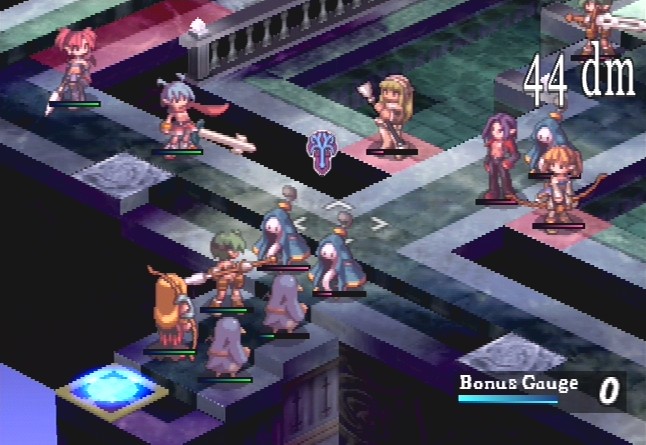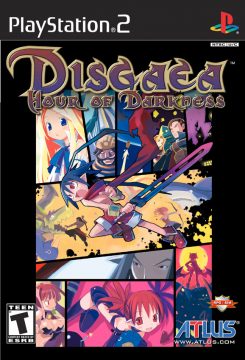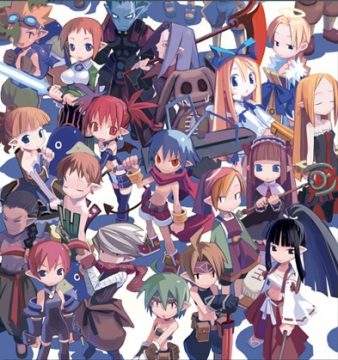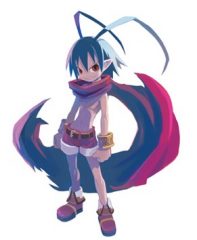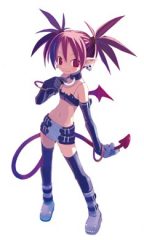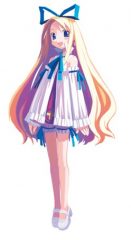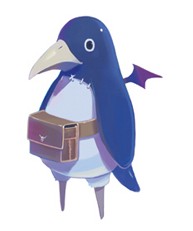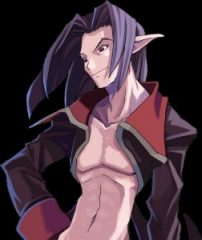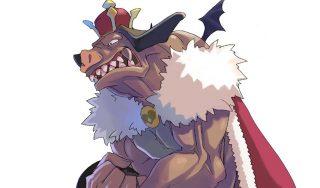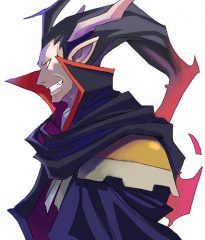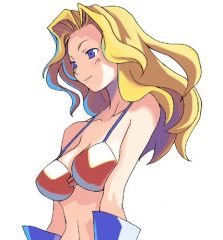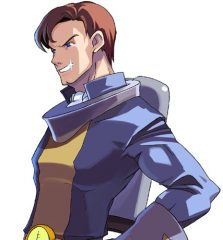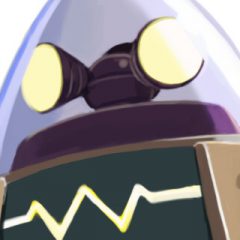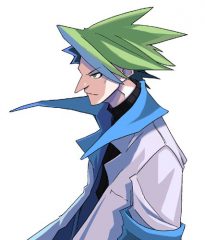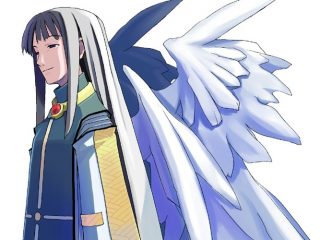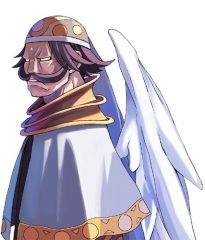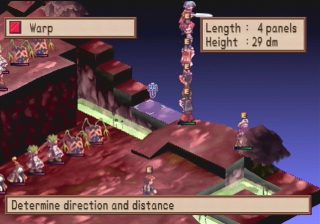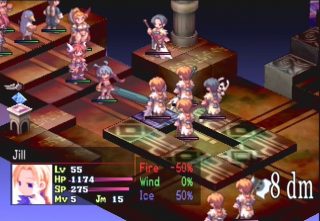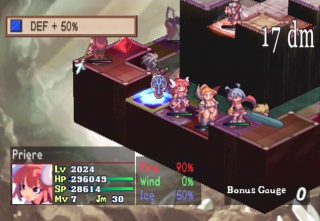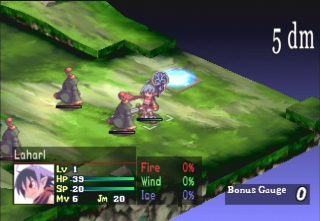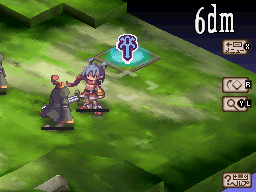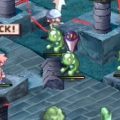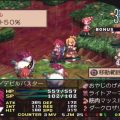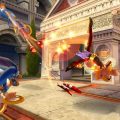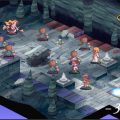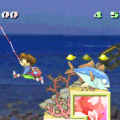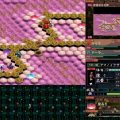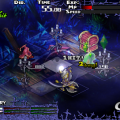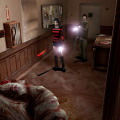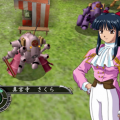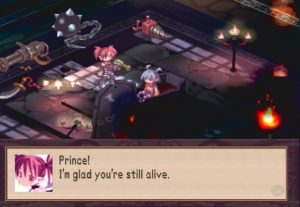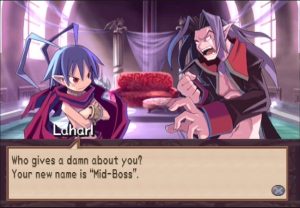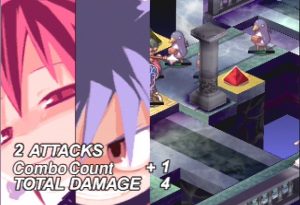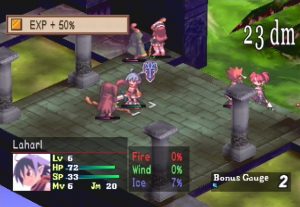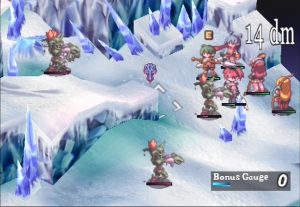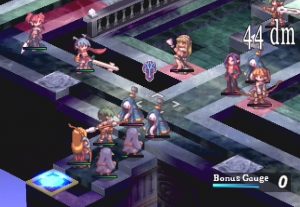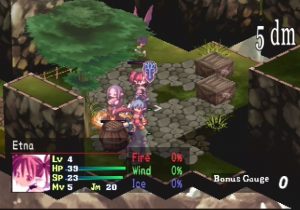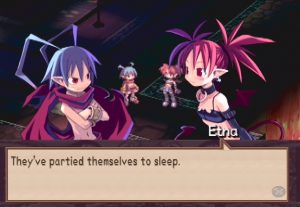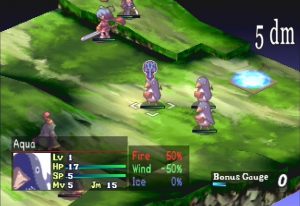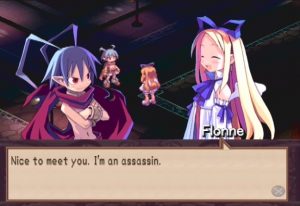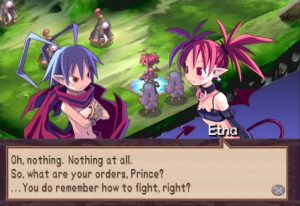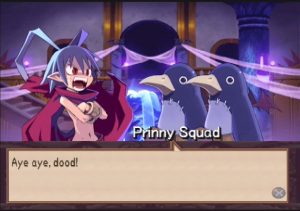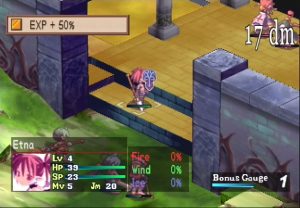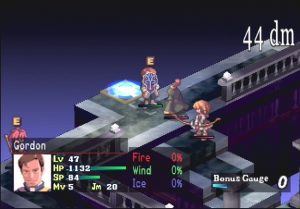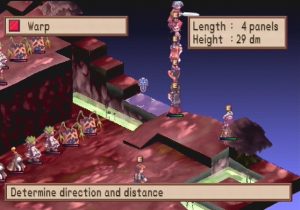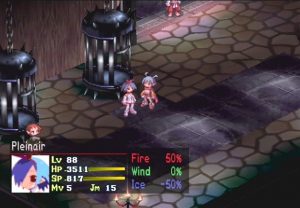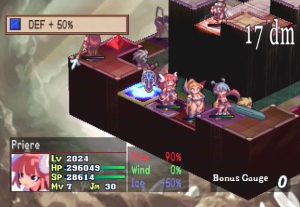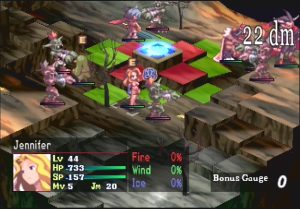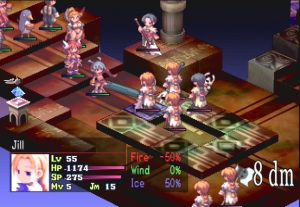- Disgaea: Hour of Darkness
- Disgaea 2: Cursed Memories
- Disgaea 3: Absence of Justice
With La Pucelle dealing with angels and heaven and whatnot, its successor, Disgaea, takes a look at the opposite side of the coin, dealing with demons and other nasty creatures. As it turns out, things aren’t going so well in the netherworld (also referred to as “makai” in Japanese), now that the king has been killed. With Prince Laharl (and rightful successor to the throne) taking an extraordinarily long nap, other demon kings begin to vy for the power to rule the netherworld.
Characters
Laharl
The farthest thing from a sleeping beauty, the Prince is awoken suddenly from his deep slumber, and is more than a little annoyed at his current situation. Laharl is the SRPG equivalent of The Grinch, a grumpy little bastard that hates everything and everyone, and especially despises that thing called “love.”
Etna
Laharl’s servant Etna awakens him from his two year sleep, and while she seems to have his best intentions in hand, she appears to be hiding something. Etna is a mischievious little demon girl that knows how to get on Laharl’s bad side and delightfully teases him, in spite of his constant death threats.
Flonne
Flonne is an Angel Trainee, sent by the heavens into the netherworld to kill the demon king. After botching the most polite assassination attempt known to mankind, Flonne eventually joins up with the netherworld crew to become their friends. Naturally, her cheery demeanor annoys the living hell out of Laharl. Flonne is also not incredibly smart, although she is very sweet.
Prinny Squad
Prinnies are zombie penguins, and are technically the reincarnated souls of sinners, who need to atone for their past transgressions. They are also not too bright, and would rather goof off than do any work. They’re incredibly weak, although they explode quite nicely whenever you throw them. Their favorite expression is “dood!” They technically follow Etna, but answer more closely to the pink colored Big Sis Prinny.
Mid Boss
This guy is one of the first characters Laharl and gang meets. He’s is a rather flamboyant demon lord named Vyers – whom Laharl quickly renames “Mid-Boss” and dismisses immediately. He ends up becoming not only a recurring comic relief, but an important part of the plot too.
Hoggmeiser / Zenisuki
A former vassal of the king, Hoggmeiser is a boar-like demon who houses great riches, which Laharl and troop try to steal. He’s the boss of the chapter, and you can choose to kill him, or have him join along.
Jennifer, Gordon and Thursday
A trio from the human world that seems to have been ripped out of a 50s sci-fi serial. They’ve been sent to the Netherworld in hopes wipe them out to prevent any impending war. Naturally, this is where Laharl and his friends get entangled with them.
Kurtis
The nemesis of Jennifer and pals, Kurtis is mostly cyborg. He ends up sacrificing himself for the greater good, and returns as a green colored Prinny, who then joins your squad and becomes a defender of Earth.
Lamington
The head seraph, Lamington is the leader of Celestia, the world of angels. He’s actually very clam and laid back, despite his immense power.
Naturally, this isn’t the kind of dark and gloomy netherworld that you’d find in, say, a Shin Megami Tensei game. It’s a goofy placed filled with music that could be straight from Disney’s Electric Light Parade. Disgaea‘s lighthearted tone mixed with light horror is often compared to goth kid favorite The Nightmare Before Christmas. The character designer has also changed from La Pucelle, with all of the artwork done by Takahito Narada. His drawing style is a bit more distinctive than Yoshiharu Nomura’s, and its cuteness nicely clashes with the dark locales of the game.
While it starts off silly, the drama eventually picks up as the story goes on – much involving the sacrifices of Laharl’s parents – but there’s rarely a time when something silly isn’t happening. Each chapter ends with a “next episode” preview narrated by Etna, who routinely makes up absurdly exaggerated stories and attempts to steal the limelight as the main character. All of the main characters have a delightful chemistry, and just listening to them interact is reason enough to get involved with the game. Which, thankfully, has seen quite a few improvements since La Pucelle. The turn and equipment systems work pretty much the same way, but there are lots of differences otherwise.
First off, the battle cutscenes have been ditched entirely for Disgaea (and each game afterward), giving the pace a much needed kick in the pants. However, adjacent characters can still join for combos, providing they’re compatible with each other. There are a lot more human classes in the game, each with incredibly cute designs, like the samurai girls, or the witches dressed up as maids. The female archer character became so popular that it was also put in Phantom Brave, and Plenair, the tutorial master, who is kind of the unofficial mascot for Harada the artist (and by association, Nippon Ichi.) You no longer need to recruit characters, but instead can create any character class you wish, as long as you’ve encountered it at some point in the game. In order to create a new character, you must pick one of your current units and sacrifice some of his Mana, which is obtained by killing enemies. If you pump a new character with more Mana, they’ll start at a higher level. The two characters also share a master/pupil relationship. If the master and pupil are adjacent and the pupil casts a spell, the master will eventually learn it. The master also gains some stats whenever the pupil levels up. Additionally, if you want to create hybrid characters with skills from different classes, you can “transmigrate” them, which sends them back to level one, but lets them keep most of their skills.
There’s also the demon senate, where you can propose various actions, like stocking the store with more expensive items. You have a chance that your proposal could be voted down, but you can bribe senators if you wish. And if the vote doesn’t go your way, you can always just kill them instead, although you need to be at a really high level to end stand a chance. You have to love democracy in the underworld.
On the battlefield, there are a few new tricks too. You can pick up and throw any character, allowing you to circumvent barries or gain some extra distance. The biggest change in the system is that the portals from La Pucelle are gone, replaced by “geo panels”. Some tiles on the battlefield are colored – the properties of these tiles can be modified by tossing geo stones on them. If you find a geo stone that, say, increases your defense by 50%, toss it on a red tile. Now any character standing on a red tile will gain a 50% defense boost, whether it be friend or foe. That’s not so hard, but it gets a bit more complicated. Destroying certain geo stones will alter the color of whatever tile it happens to be sitting on. This affects every like-colored tile on the board. For another example, a certain geo stone will cause tiles to turn red when it’s destroyed. Toss it on a blue tile, give it a good whack, and now every blue tile on the board will turn red. Any unit standing on a red tile will also take damage. It’s more than a little bit confusing at first, but playing with geo stones to put the advantage in your court can be pretty important.
If that wasn’t crazy enough, there’s the Item World. You see, within each every piece of equipment in the game, there’s a little world filled with mini inhabitants. You can shrink yourself and enter any item, which takes you to a randomly generated dungeon. Making your way through these stages will eventually level up whatever item you’ve decided to adventure into. It’s completely crazy, but that’s why games like Disgaea are amazing.
Another tradition introduced here are the cameo characters. In the depths of the netherworld, you can find Prier (from La Pucelle) and Marjorly (from Rhapsody / Marl’s Kingdom), all decked out in demon outfits. They’re extraordinarily powerful, and the only way to beat them is through long bouts of power leveling. Thankfully, the New Game+ lets you start from the beginning of the game after you’ve beaten it, keeping your characters statistics intact. There are also several endings, depending on a variety of factors (treating your allied characters well is extremely important – make sure not to kill too many of them.)
A recurring thread with Nippon Ichi game, including Disgaea, they don’t seem balanced quite right. It’s not uncommon to be playing just fine, and then all of a sudden, come to a stumbling block where you need to spend a good amount of time leveling up. Most Nippon Ichi games have a roster of story characters, which you’ll obtain throughout the game, but there are also generic characters you can create. Although there are plenty of options to do this, these new units often start at a low level. In other words, every time you bring someone new into the party, you need to spend a good amount of time leveling just so they can remotely catch up with their comrades. Making sure all of your characters are properly leveled is important, because characters that lag behind too far will become completely useless. The annoying AI doesn’t help either, as they’re often trained to go after the character with the lowest HP. This means that characters that are inherently weak (magic users, mostly) usually end up being prime targets, and disposed of immediately.
That being said, the amount of grinding needed to enjoying a Nippon Ichi game tends to be vastly overstated. You’ll usually need to do it a few times throughout the course of a given game – the later games are better balanced than the earlier ones, at least – but completing the main story mode is rarely too arduous. It’s usually the post game objectives – bonus stages, additional endings, super bosses – that require the real grinding. This leads to hardcore gamers on forums bragging about how they spend hundreds of hours to get their character to reach levels reaching into the thousands. It does lead to a lot of play time, if that’s your thing, so you get a lot of game for your cash, and there’s a certain satisfaction in making your characters so powerful that they’re just stupidly beyond belief.
Disgaea is the most popular of the Nippon Ichi games, in both the East and the West. It has an irresistible appeal created by hilarious character and gameplay that’s as indepth as you want it to be, without going too overboard.
Atlus USA ended up adding two additional songs in the game for use as trailers, both by the rock band Tsunami Bomb. You can also pick both English and Japanese voices for the game, which is also a feature in all other North American localized Nippon Ichi games. Usually the Japanese track is removed from European releases.
After Disgaea‘s breakout success, Nippon Ichi went on to port Disgaea to the portable platforms. The PSP version, subtitled “Afternoon of Darkness” in English, was released in 2006 in Japan and 2007 in America. It’s essentially a perfect port, with all of the graphics, music, and dual language voices intact, in addition to the widescreen display. There are some tiny additions, like a brief prologue describing Laharl, but the most sizable feature is the Etna Mode. This is a set of episode taking place in an alternate reality where Etna accidentally kills Laharl in the beginning, and sets off to take over the demon kingdom herself. All of the old dialogue is taken from the Atlus translation, as well as most of the voicework, although Etna has a new voice actress to stay consistent with Disgaea 2. Additionally, there are a handful of extra battles, and Zetta (from Makai Kingdom) and Adell and Rozalin (from Disgaea 2) show up as hidden bosses. Finally, there’s a multiplayer mode (local only) with two new additions – Geo Cubes, which can used to enhance abilities, summon monsters, or attack enemies with, and Demon Gadgets, which randomly appear on the battlefield and power your units up. You can also turn off attack animations to speed things up, and purchase various songs for use in the Item World, so you don’t have to listen to the same grating song over and over. There’s also a new secret room where you can read Etna’s diary. However, the Tsunami Bomb songs from the PS2 version have been removed, and there are a couple of bugs, including one that freezes the game if there are too many counter attacks at the same time.
The Nintendo DS version, released in 2008 and subtitled “Makai no Ouji to Akai Tsuki” (“The Demon Prince and the Red Moon”) in Japan, contains nearly all of the same additions as the PSP version, including the ability to recruit the hidden bosses Zetta, Adell and Rozalin. You can also (finally) recruit Plenair, who’s quite powerful. There’s also a Prinny Commentary mode, unlocked when you beat the game, where the Prinny’s narrate the events (through text) on the top screen, and even after all of the subsequent ports, remains exclusive to this version. Even though these additions are nice, the port itself is fairly average. Since the DS has a drastically lower resolution than both the PS2 and PSP, everything feels really squished when fully zoomed in, and really tiny and pixellated when zoomed out.
The scrolling is choppy and the lack of analog cursor movement is frustrating. Even though it uses touch screen controls, they’re poorly implemented and tough to use. Sometimes the screen gets so cluttered with menus that it blocks the view, requiring you to look at the top screen (which displays a map) just so see what you’re targeting. Additionally, a good chunk of the voice acting has been cut – only the first chapter and “next episode” are voiced, and there’s only a single language choice. The rearranged music sounds pretty bad too. It’s playable, but compromised – the PSP version is definitely the obvious choice for portable gaming, even if it’s not quite as comprehensive.
The Windows port is based on the PSP version but adds in the extra characters of the DS game and uses higher resolution character portraits. It was then ported again to Windows, PlayStation 4, and Switch under the name Disgaea 1 Complete. This version improves the sprites to make them consistent with the HD games, but otherwise doesn’t add much of anything new.
